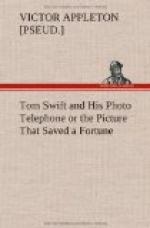“Hold on, Tom!” protested Mr. Swift. “I give up! Don’t rub it in on your old dad. I admit that folks did laugh at those inventors, with their seemingly impossible schemes, but they made good. And you’ve made good lots of times where I thought you wouldn’t. But just stop to consider for a moment. This thing of sending a picture over a telephone wire is totally out of the question, and entirely opposed to all the principles of science.”
“What do I care for principles of science?” cried Tom, and he strode about the room so rapidly that Eradicate, the old colored servant, who came in with the mail, skipped out of the library with the remark:
“Deed, an’ Massa Tom must be pow’fully preragitated dis mawnin’!”
“Some of the scientists said it was totally opposed to all natural laws when I planned my electric rifle,” went on Tom. “But I made it, and it shot. They said my air glider would never stay up, but she did.”
“But, Tom, this is different. You are talking of sending light waves—one of the most delicate forms of motion in the world—over a material wire. It can’t be done!”
“Look here, Dad!” exclaimed Tom, coming to a halt in front of his parent. “What is light, anyhow? Merely another form of motion; isn’t it?”
“Well, yes, Tom, I suppose it is.”
“Of course it is,” said Tom. “With vibrations of a certain length and rapidity we get sound—the faster the vibration per second the higher the sound note. Now, then, we have sound waves, or vibrations, traveling at the rate of a mile in a little less than five seconds; that is, with the air at a temperature of sixty degrees. With each increase of a degree of temperature we get an increase of about a foot per second in the rapidity with which sound travels.”
“Now, then, light shoots along at the rate of 186,000,000 miles a second. That is more than many times around the earth in a second of time. So we have sound, one kind of wave motion, or energy; we have light, a higher degree of vibration or wave motion, and then we come to electricity—and nobody has ever yet exactly measured the intensity or speed of the electric vibrations.”
“But what I’m getting at is this—that electricity must travel pretty nearly as fast as light—if not faster. So I believe that electricity and light have about the same kind of vibrations, or wave motion.”
“Now, then, if they do have—and I admit it’s up to me to prove it,” went on Tom, earnestly—“why can’t I send light-waves over a wire, as well as electrical waves?”
Mr. Swift was silent for a moment. Then he said, slowly:
“Well, Tom, I never heard it argued just that way before. Maybe there’s something in your photo telephone after all. But it never has been done. You can’t deny that!”
He looked at his son triumphantly. It was not because he wanted to get the better of him in argument, that Mr. Swift held to his own views; but he wanted to bring out the best that was in his offspring. Tom accepted the challenge instantly.




